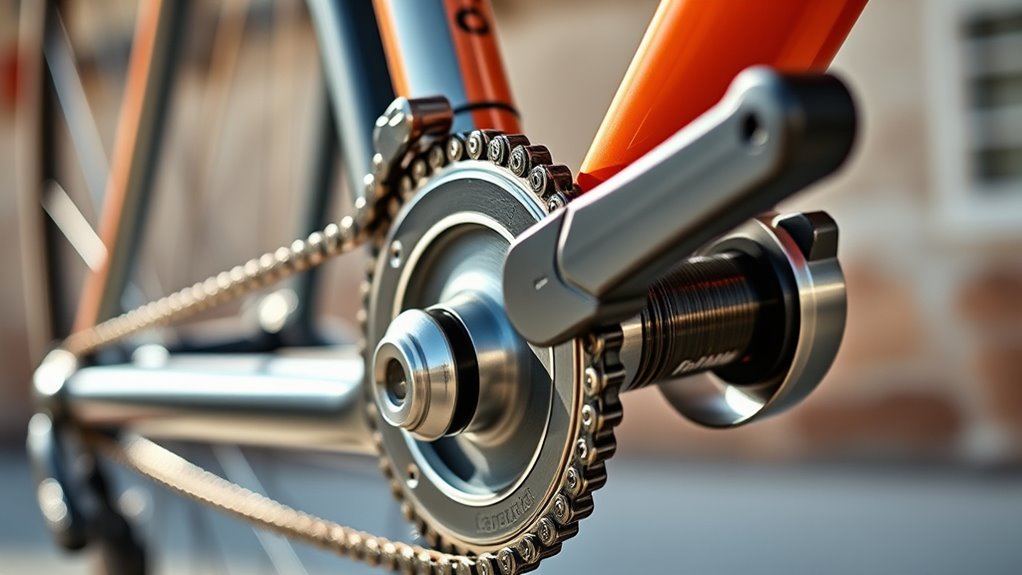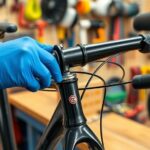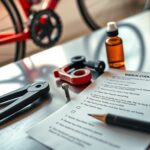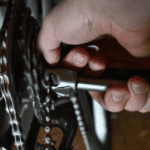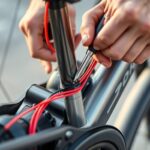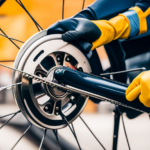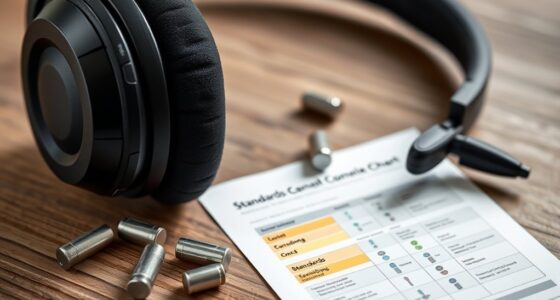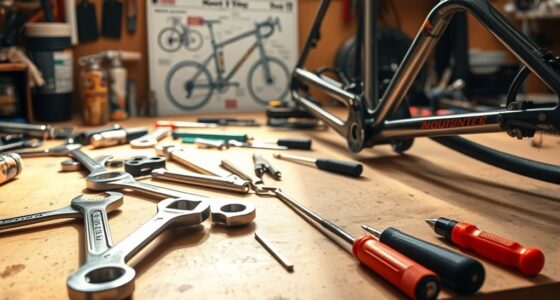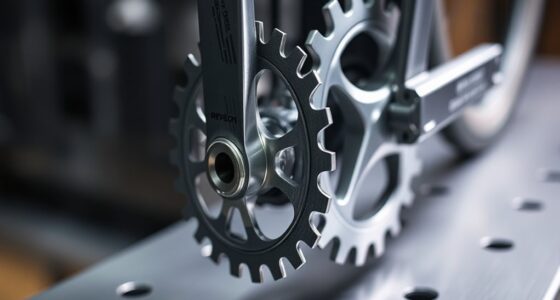To keep your custom-built bike running smoothly, perform regular safety checks on components like hubs, tires, and drivetrain. Keep your tires properly inflated and inspect them for damage, replacing worn or cracked tires promptly. Adjust and maintain your brakes and gears for precise shifting and stopping. Clean and lubricate the drivetrain often, and tighten all bolts securely using the right tools. Proper storage and seasonal maintenance also extend your bike’s lifespan—stay tuned for more expert tips to get the most from your bike.
Key Takeaways
- Regularly inspect and tighten all bolts, including handlebars, seat post, and quick-release skewers, using a torque wrench to prevent loosening.
- Check tire pressure before every ride and inspect tires for cracks, embedded debris, or wear; replace damaged tires promptly.
- Clean and lubricate the drivetrain, including chain, cassette, and chainrings, to ensure smooth shifting and prevent rust.
- Examine brake pads for wear, adjust cable tension for responsive braking, and clean brake surfaces to maintain braking performance.
- Store your bike indoors in a dry, temperature-controlled space, reduce tire pressure for long-term storage, and periodically lubricate moving parts.
Conducting Routine Safety Checks Before Riding
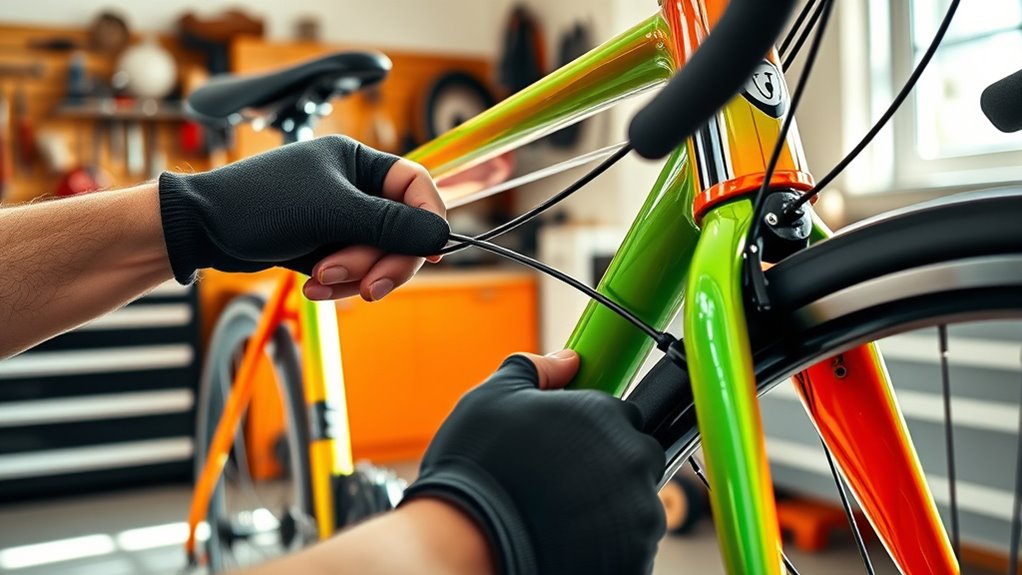
Before each ride, it’s vital to perform a quick safety check to make sure your bike is ready. Start by inspecting your tire pressure, ensuring it’s at the recommended level for maximum grip and comfort. Check brake engagement by squeezing the levers; they should feel firm and engage smoothly to provide reliable stopping power. Examine the chain condition for any rust, slack, or damage, and lubricate if needed. Spin your wheels to detect wobbles or misalignment—true them if necessary. Confirm that quick-release skewers and thru axles are securely tightened to prevent wheel detachment. Finally, tighten all bolts on handlebars, seat post, and accessories to manufacturer specs. Conducting a routine safety check helps prevent component failure and keeps your ride safe and smooth. Regularly inspecting your bike’s drivetrain and brake systems ensures optimal performance and safety during your rides. Additionally, consider checking your air pressure and tire condition, especially if you notice any issues with handling or comfort. Remember to also verify the condition of your electric components, if applicable, to ensure reliable operation.
Ensuring Proper Tire Inflation and Inspecting for Damage

Ensuring your tires are properly inflated and free of damage is essential for a safe and efficient ride. Here’s what you should do:
- Check the tire sidewall for the recommended PSI range and inflate slowly using a reliable pressure gauge to ensure proper seating of the bead. Proper tire pressure not only improves ride quality but also extends the lifespan of your tires. Maintaining correct tire pressure is especially important because air pressure loss can occur naturally over time, impacting performance. Regularly monitoring your tire maintenance helps prevent unexpected flats and ensures optimal performance. Additionally, use a pressure gauge to verify the exact PSI; relying solely on visual inspection may not be accurate enough for optimal inflation.
- Inspect tires for cracks, dry rot, embedded debris, or significant wear, especially if the bike hasn’t been used in a while.
- Verify tire pressure before each ride, maintaining it within the manufacturer’s recommended range.
- Remember that tires naturally lose a small amount of air daily; re-inflate as needed to avoid under-inflation during your ride.
- Regularly assess your tires for signs of dry rot or other damage to prevent flats and ensure optimal performance.
Replacing tires with dry rot or major damage guarantees safety and prevents flats.
Maintaining and Adjusting Brakes and Gears
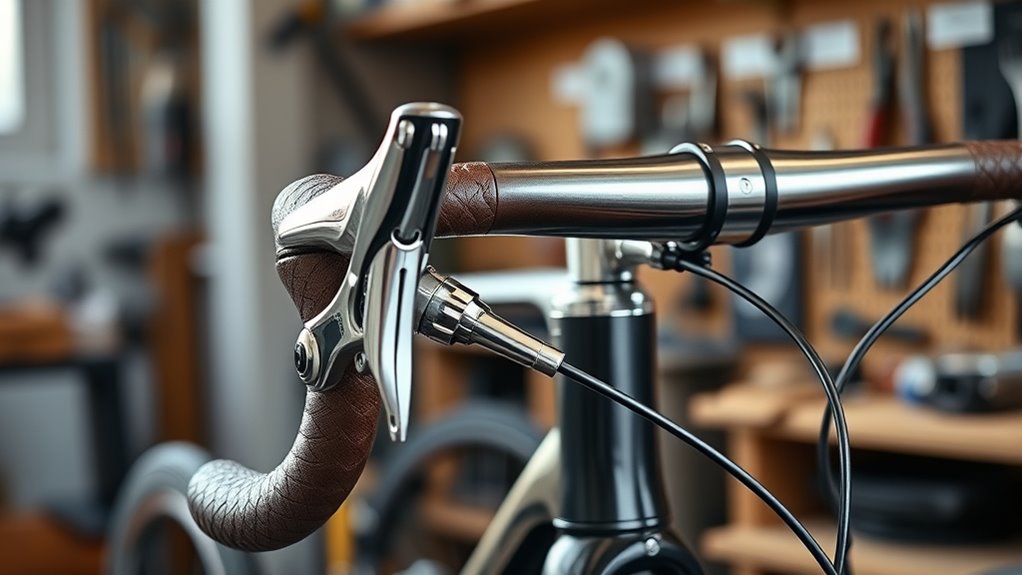
Regularly inspecting and adjusting your brakes and gears keeps your bike performing at its best and guarantees safe riding conditions. For brake adjustment, check the brake pads for wear; replace them if grooves fade or response diminishes. Confirm the brake cable tension allows levers to engage fully without excessive pull, providing reliable stopping power. For gear tuning, focus on derailleur alignment by fine-tuning limit screws and barrel adjusters to achieve smooth shifting across all gears. Periodically clean and lubricate brake and gear cables to prevent rust, fraying, and sluggish shifting. Additionally, inspecting the contrast ratio of your bicycle’s lighting system can improve visibility and safety during night rides. Also, inspect for contamination on brake surfaces and pads, cleaning with disc brake cleaner or rubbing alcohol to maintain peak braking performance. Proper maintenance of brakes and gears ensures safe, efficient rides every time. Unexpected silly tantrums during family photoshoots can add humor and memorable moments to your sessions.
Cleaning and Lubricating Drivetrain Components
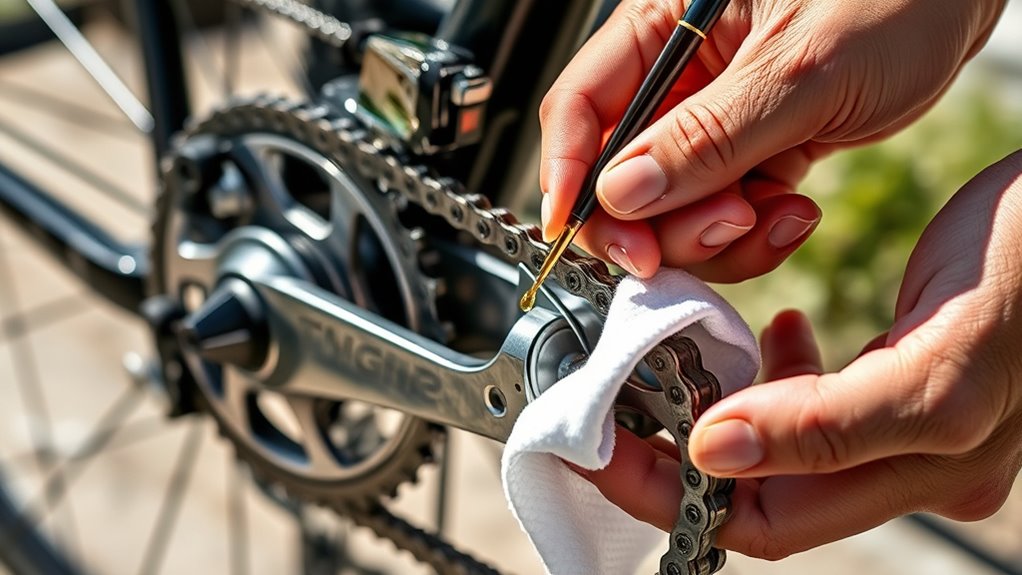
Keeping your drivetrain clean is essential for smooth shifting and efficient pedaling. To maintain optimal performance, follow these steps:
- Use a biodegradable degreaser and a brush to thoroughly clean your chain, cassette, and chainrings, removing dirt and grime.
- After cleaning, apply a bicycle-specific chain lubricant evenly on the inside of the chain while turning the pedals backward.
- Wipe off any excess lubricant with a clean rag to prevent dirt buildup and ensure smooth operation.
- Regularly inspect your chain for wear using a chain checker tool; replace it before wear exceeds 0.5% to prevent unnecessary wear on other components.
- Remember that proper cleaning and lubrication can also extend the lifespan of your drivetrain components, which is especially important for custom-built bicycles that often have specialized setups.
- Additionally, maintaining a clean drivetrain reduces mechanical failures and keeps your bike running reliably for longer periods.
- Incorporating AI-based diagnostics can help identify early signs of component wear, ensuring timely maintenance and optimal bike performance.
Regularly Tightening and Securing Bolts and Fasteners
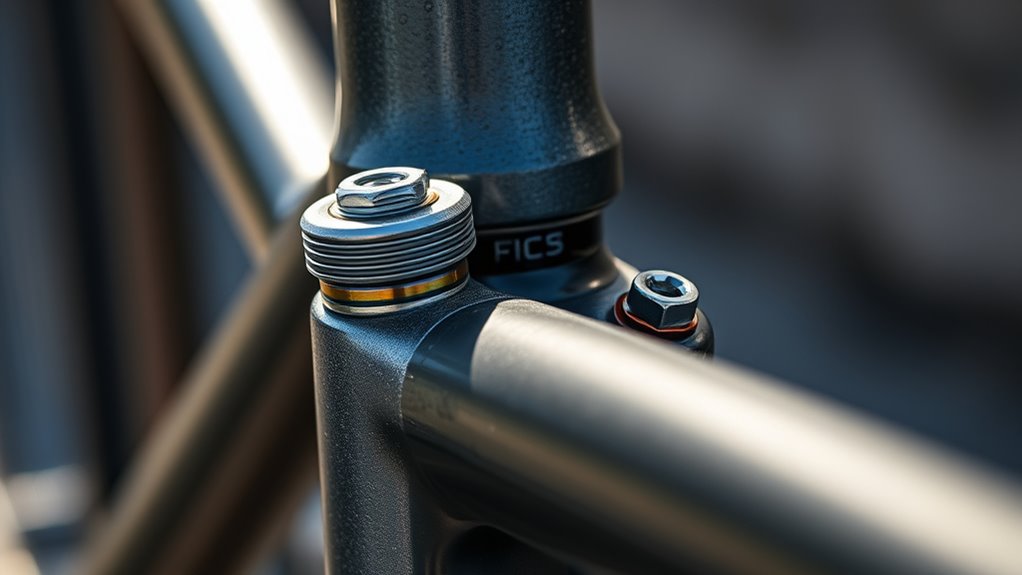
Checking and tightening your bike’s bolts and fasteners should be part of your routine before every ride, as loose components can compromise safety and performance. Use a torque wrench to ascertain bolt tightening matches the manufacturer’s specifications, typically between 4 to 8 Nm for key parts like stem bolts and handlebar clamps. Focus on critical connection points to prevent component shifts that could affect handling or safety. Incorporate a routine inspection of all fasteners, tightening them in a crisscross pattern for even stress distribution. Applying thread-locking compounds, like Loctite, on certain fasteners can help prevent loosening due to vibration. Always avoid over-tightening, especially on carbon fiber parts, to prevent damage and ensure your bike remains safe and reliable. Regularly inspecting your candy packaging and storage areas can also help maintain the integrity of your components. Additionally, understanding the importance of attention to detail can help you catch small issues before they become larger problems. Maintaining proper fastener torque is essential for ensuring your bike’s longevity and safety. Being aware of exfoliation benefits and how they impact your bike’s components can also contribute to better maintenance routines. Remember that proper maintenance extends the lifespan of your bicycle and enhances your riding experience.
Monitoring and Replacing Worn Components
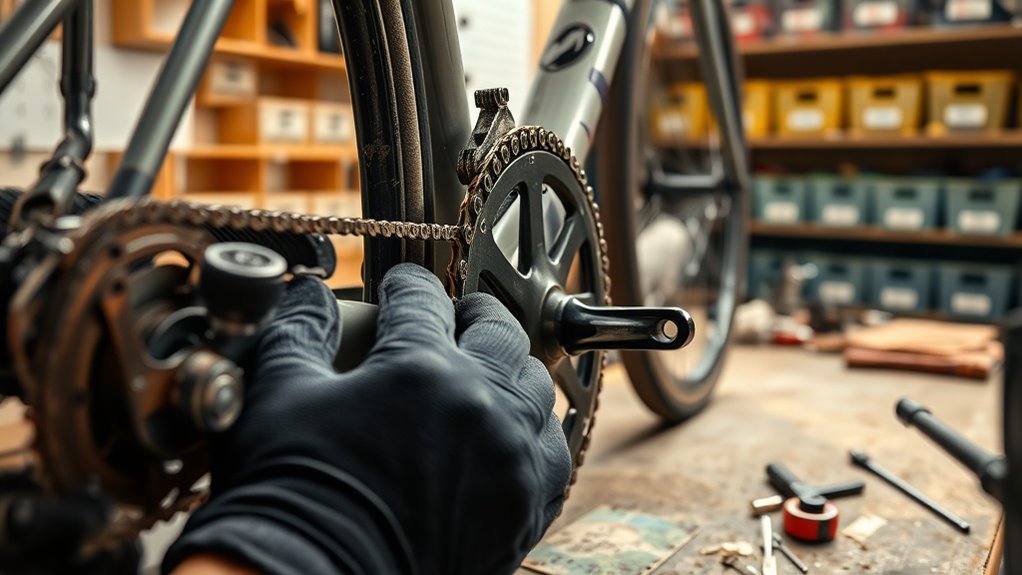
Monitoring your bike’s components for wear is essential to guarantee safe and smooth rides. Regularly inspect key parts to catch worn components early. Here are four tips to keep your bike in top shape:
- Use a chain checker to assess chain wear; replace the chain before it elongates excessively to protect your drivetrain.
- Check brake pads for thickness; replace them when the friction material reaches about 1-2 mm for reliable stopping power.
- Inspect wheel and hub bearings for looseness or roughness; replace or service bearings as needed.
- Examine tires for cracks, dry rot, or debris; replace tires showing significant deterioration for safety and performance.
- Be attentive to the overall condition of your components, especially those related to your bike’s spiritual and emotional connection, to ensure a smooth and harmonious ride.
Staying vigilant about component wear prevents breakdowns and extends your bike’s lifespan.
Proper Storage and Seasonal Maintenance Tips
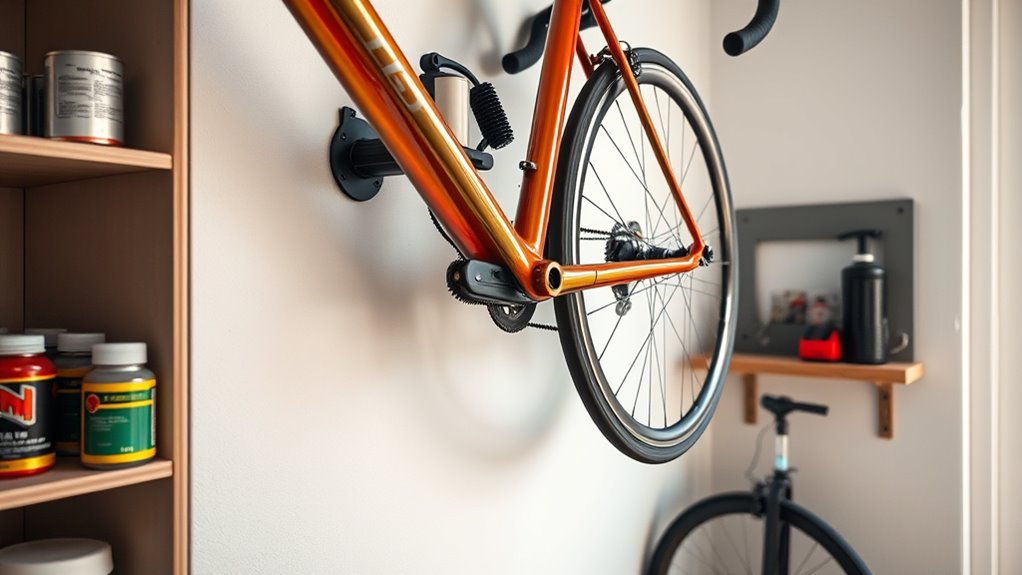
Proper storage and seasonal maintenance are essential to preserving your bike’s condition over time. Store your bike indoors in a dry, temperature-controlled space to prevent rust and material degradation. During seasonal changes, especially winter, thoroughly clean your bike and lubricate the drivetrain, cables, and moving components to combat moisture and dirt buildup. Use bike covers or wall hooks to hang your bike securely, ensuring you avoid pressure on delicate components like the derailleur and brake levers. Before long-term storage, reduce tire pressure by about 30%, or fully deflate if storing for several months, to prevent deformation. Regularly inspect your bike for signs of corrosion, cracking, or wear, especially after off-road rides or exposure to harsh weather. Proper storage and seasonal care help extend your bike’s lifespan and maintain ideal performance.
Using the Right Tools for Effective Bike Repairs
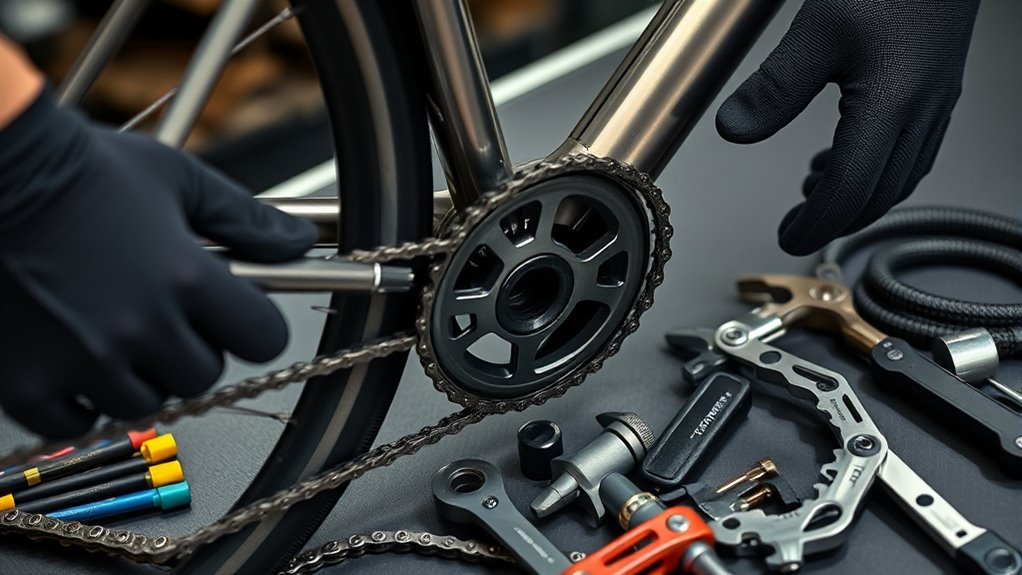
Having the right tools makes bike repairs smoother and safer. Choosing high-quality, specific tools and knowing how to use them correctly guarantees damage and ensures proper maintenance. Organizing your toolbox well helps you find what you need quickly and keeps your bike in top shape.
Essential Tool Selection
Choosing the right tools is essential for effective bike repairs, as using improper or low-quality equipment can cause damage or delays. To guarantee smooth maintenance, focus on selecting key bike tools:
- A high-quality hex/torx wrench, like the Park Tool HXS-1.2, for precise tightening without damaging components.
- A bike-specific chain breaker and chain checker to accurately measure wear and perform repairs on the spot.
- A reliable torque wrench, such as the EPAuto Torque Wrench, to tighten bolts to the correct specifications.
- Versatile tire levers and a puncture repair kit tailored to your tire type and size for quick fixes during rides.
Organizing these tools with labeled drawers or color-coded pegboards helps streamline maintenance and prevents using the wrong equipment.
Proper Tool Usage Techniques
Using the right tools correctly is essential for effective bike repairs and preventing damage. Proper tool usage guarantees you don’t strip bolts or cause unnecessary wear. Always select the correct size, like a 5mm hex wrench, to fit bolts snugly. When tightening parts, use a torque wrench to apply the manufacturer’s recommended settings, promoting safety and durability. Opt for bike-specific tools, such as a chain tool designed for bicycles, to achieve precise results. Avoid excessive force; if a tool doesn’t fit properly, double-check its size or type before proceeding. Regularly inspect and maintain your tools—clean and organize them—to ensure they work effectively when you need them. Proper tool usage is key to successful bike repair and ongoing maintenance.
Carrying and Storage Strategies
Carrying and storing your repair tools properly guarantees you’re always prepared for on-the-go fixes. To optimize your bike maintenance tips, consider these storage strategies:
- Use a compact saddle bag or frame-mounted storage to keep spare tubes, tire levers, and patches accessible during rides.
- Carry a well-organized multi-tool with essential functions like hex keys, screwdrivers, and chain breakers for quick repairs.
- Invest in a portable pump or CO₂ inflator compatible with your valve type (Presta or Schrader) for fast tire inflation.
- At home, utilize a repair stand or portable repair station to perform maintenance efficiently, keeping tools and spare parts organized and ready. Proper storage guarantees your tools are in top condition and readily available when needed.
Frequently Asked Questions
What Maintenance Should I Do on My Bike?
When you ask about bike maintenance, you should regularly check and tighten all bolts and nuts to prevent failures. Make sure your tires are properly inflated, brakes work well, and your chain is lubricated. Clean and oil your drivetrain every 500 miles or monthly. Keep your wheels true and aligned to avoid wobbling. Replace worn brake pads, chains, and tires promptly to keep your bike safe and performing at its best.
How Do I Keep My Bike in Good Condition?
To keep your bike in good shape, you should regularly inspect and tighten all bolts and quick-release levers to guarantee safety. Clean and lubricate your chain and drivetrain every 500 miles or monthly to prevent rust. Check your tire pressure before each ride and keep it within the recommended PSI. Perform ABC checks—air, brakes, and chain—and schedule annual professional tune-ups to maintain ideal performance and longevity.
How Often Should I Get My Bike Tuned Up?
You should get your bike tuned up every 3 to 6 months or every 1,000 to 2,500 miles, whichever comes first. For your custom-built bike with high-end parts, consider more frequent tune-ups every 2 to 3 months. Regular maintenance keeps everything running smoothly, catches issues early, and extends your bike’s life. Pay attention to how it rides and address problems promptly for the best performance.
Is It Okay to Hose Your Bike Down?
Hosing your bike down is okay if you use a gentle stream of water and avoid high-pressure jets. Focus on cleaning the frame, wheels, and drivetrain without spraying directly into bearings, hubs, or bottom brackets, as water can cause damage. After rinsing, dry your bike thoroughly and lubricate moving parts. This helps prevent rust and keeps your bike running smoothly without risking unnecessary wear or damage.
Conclusion
By regularly tending to your bike, you keep its spirit lively and its journey smooth. Think of your maintenance routine as gentle whispering to a trusted companion, ensuring every part hums in harmony. When you give your bike this tender care, it rewards you with effortless rides and countless adventures ahead. Embrace these simple habits, and you’ll find your cycling experience becomes a delightful dance, always ready to carry you wherever your heart desires.
